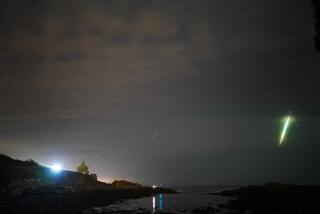Meteor shower: Lyrids make big boom in trek through Earth’s skies
There is something about bright lights and loud noises that attract the child in all of us. And when they come from the heavens, they’re fodder for even our adult selves.
Take meteor showers, for example.
Over the weekend, the Lyrids made their annual spin through the local skies, igniting the usual flashes, as they’ve done for some 2,600 years. This time, they also seemed to have caused an explosive boom heard in some parts of California and Nevada.
This year’s show was a bit more spectacular than in the past, because the moon was in a new phase -- meaning the sky was darker than usual, creating a nice, rich background that showcased the celestial sparks. The peak of fun was over the weekend, but there’s likely to be some more activity over the next few days.
The lights will be sporadic and well below the spectacle level of the weekend, but keep this general meteor-watching principle in mind: Visibility varies with location, brightness of other astronomical phenomena, and the level of pollution from light sources (such as human activity in cities).
Meteor showers -- there are several each year -- are named for the constellation from which it appears they’re coming. The Lyrids are named for Lyra the Harp, but they’re actually the debris from the comet Thatcher. The dust from that comet usually hits Earth’s atmosphere by the last quarter of April.
Perhaps the most famous meteor shower is the Perseids, the annual summer show that starts around the end of July and peaks early in August; then, as many as 60 meteors per hour can light up the sky. The Lyrids, by comparison, run about 20 an hour during the peak time periods.
The year’s meteor showers got off to a start with the Quadrantids and will finish with the Geminids, peaking this year around Dec. 13.
The Geminids are noted for their intensity, as many as 130 meters an hour, making them more intense than even the Perseids. The Geminids are also the offspring of an asteroid rather than a comet.
ALSO:
Would you buy a $60 energy-efficient light bulb?
Spring snow: East Coast hasn’t seen storm like this since 1928
Supreme Court disappoints landlords, rejects rent-control challenge
More to Read
Sign up for Essential California
The most important California stories and recommendations in your inbox every morning.
You may occasionally receive promotional content from the Los Angeles Times.











